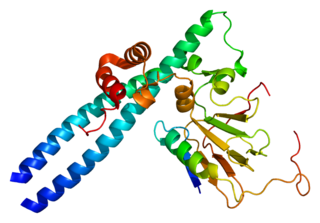Cyclin-A2 is a protein that in humans is encoded by the CCNA2 gene. [5] It is one of the two types of cyclin A: cyclin A1 is expressed during meiosis and embryogenesis while cyclin A2 is expressed in the mitotic division of somatic cells. [6]
Cyclin-A2 is a protein that in humans is encoded by the CCNA2 gene. [5] It is one of the two types of cyclin A: cyclin A1 is expressed during meiosis and embryogenesis while cyclin A2 is expressed in the mitotic division of somatic cells. [6]
Cyclin A2 belongs to the cyclin family, whose members regulate cell cycle progression by interacting with CDK kinases. Cyclin A2 is unique in that it can activate two different CDK kinases; it binds CDK2 during S phase, and CDK1 during the transition from G2 to M phase. [7]
Cyclin A2 is synthesized at the onset of S phase and localizes to the nucleus, where the cyclin A2-CDK2 complex is implicated in the initiation and progression of DNA synthesis. Phosphorylation of CDC6 and MCM4 by the cyclin A2-CDK2 complex prevents re-replication of DNA during the cell cycle. [6]
Cyclin A2 is involved in the G2/M transition but it cannot independently form a maturation promoting factor (MPF). [8] Recent studies have shown that the cyclin A2-CDK1 complex triggers cyclin B1-CDK1 activation which results in chromatin condensation and the breakdown of the nuclear envelope. [9]
The levels of cyclin A2 are tightly synchronized with the progression of the cell cycle. [10] Transcription initiates in late G1, peaks and plateaus in mid-S, and declines in G2. [10] [6]
Cyclin A2 transcription is mostly regulated by the transcription factor E2F and begins in G1, after the R point. [10] [6] Absence of cyclin A2 before the R point is due to the E2F inhibition by hypophosphorylated retinoblastoma protein (pRb). After the R point, pRb is phosphorylated and can no longer bind E2F, leading to cyclin A2 transcription. [11] [12] The cyclin A2-CDK2 complex eventually phosphorylates E2F, turning off cyclin A2 transcription. [10] E2F promotes cyclin A2 transcription by de-repressing the promoter. [10] [11]
Cyclin A2 has been shown to interact with:
Cyclin A2 regulates homologous recombinational DNA repair in human breast cancer cells [21] Loss of cyclin A2 causes high rates of double-strand breaks in DNA. The increase in double-strand breaks is a consequence of defective homologous recombinational repair of the breaks resulting from reduced MRE11 and RAD51 DNA repair proteins. [21] Cyclin A2 mediates the abundance of MRE11 nuclease by binding to Mre11 mRNA. Cyclin A2 mediates the abundance of RAD51 protein by inhibiting proteasome degradation of this protein.
During mouse development and aging, cyclin A2 promotes DNA repair, particularly double-strand break repair, in the brain. [22] Also in mice, cyclin A2 was found to be an RNA binding protein that controls the translation of Mre11 mRNA. [23]
Cyclin A2 (Ccna2) is a key protein involved in the direction of mammalian cardiac myocytes to grow and divide, and has been shown to induce cardiac repair following myocardial infarction. [24] Normally, Ccna2 is silenced postnatally in mammalian cardiac myocytes. Because of this gene silencing, adult heart muscle cells cannot divide readily to repair and regenerate after a heart attack. [24]
Ccna2 has been found to induce cardiac repair in small-animal models following myocardial infarction. [24] Preclinical trials involving injections of adenovirus which contained the Ccna2 gene into infarcted porcine (pig) hearts has shown to be protective of MI in pig hearts. [24] Ccna2 mediated cardiac repair showed both a decrease in fibrosis in the peri-infarct tissue and a greater number of cardiomyocytes at the sites of injection. [24] Delivery of Ccna2 into cardiac tissue invokes a regenerative response and markedly enhances cardiac function. [24] [25] [26]
Increased expression of cyclin A2 has been observed in many types of cancer such as breast, cervical, liver, and lung among others. [6] [27] [28] [29] [30] While it is not clear whether increased expression of cyclin A2 is a cause or result of tumorigenesis, it is indicative of prognostic values such as predictions of survival or relapse. [6]
Overexpression of cyclin A2 in mammalian cells can result in the delayed onset of metaphase and anaphase. [31] It is also possible that cyclin A2-CDK contributes to tumorigenesis by the phosphorylation of oncoproteins or tumor suppressors like p53. [32]

The cell cycle, or cell-division cycle, is the series of events that take place in a cell that causes it to divide into two daughter cells. These events include the duplication of its DNA and some of its organelles, and subsequently the partitioning of its cytoplasm, chromosomes and other components into two daughter cells in a process called cell division.

Cyclin-dependent kinases (CDKs) are the families of protein kinases first discovered for their role in regulating the cell cycle. They are also involved in regulating transcription, mRNA processing, and the differentiation of nerve cells. They are present in all known eukaryotes, and their regulatory function in the cell cycle has been evolutionarily conserved. In fact, yeast cells can proliferate normally when their CDK gene has been replaced with the homologous human gene. CDKs are relatively small proteins, with molecular weights ranging from 34 to 40 kDa, and contain little more than the kinase domain. By definition, a CDK binds a regulatory protein called a cyclin. Without cyclin, CDK has little kinase activity; only the cyclin-CDK complex is an active kinase but its activity can be typically further modulated by phosphorylation and other binding proteins, like p27. CDKs phosphorylate their substrates on serines and threonines, so they are serine-threonine kinases. The consensus sequence for the phosphorylation site in the amino acid sequence of a CDK substrate is [S/T*]PX[K/R], where S/T* is the phosphorylated serine or threonine, P is proline, X is any amino acid, K is lysine, and R is arginine.
E2F is a group of genes that encodes a family of transcription factors (TF) in higher eukaryotes. Three of them are activators: E2F1, 2 and E2F3a. Six others act as suppressors: E2F3b, E2F4-8. All of them are involved in the cell cycle regulation and synthesis of DNA in mammalian cells. E2Fs as TFs bind to the TTTCCCGC consensus binding site in the target promoter sequence.

Cell cycle checkpoints are control mechanisms in the eukaryotic cell cycle which ensure its proper progression. Each checkpoint serves as a potential termination point along the cell cycle, during which the conditions of the cell are assessed, with progression through the various phases of the cell cycle occurring only when favorable conditions are met. There are many checkpoints in the cell cycle, but the three major ones are: the G1 checkpoint, also known as the Start or restriction checkpoint or Major Checkpoint; the G2/M checkpoint; and the metaphase-to-anaphase transition, also known as the spindle checkpoint. Progression through these checkpoints is largely determined by the activation of cyclin-dependent kinases by regulatory protein subunits called cyclins, different forms of which are produced at each stage of the cell cycle to control the specific events that occur therein.
Cyclin A is a member of the cyclin family, a group of proteins that function in regulating progression through the cell cycle. The stages that a cell passes through that culminate in its division and replication are collectively known as the cell cycle Since the successful division and replication of a cell is essential for its survival, the cell cycle is tightly regulated by several components to ensure the efficient and error-free progression through the cell cycle. One such regulatory component is cyclin A which plays a role in the regulation of two different cell cycle stages.

Cyclin-dependent kinase 2, also known as cell division protein kinase 2, or Cdk2, is an enzyme that in humans is encoded by the CDK2 gene. The protein encoded by this gene is a member of the cyclin-dependent kinase family of Ser/Thr protein kinases. This protein kinase is highly similar to the gene products of S. cerevisiae cdc28, and S. pombe cdc2, also known as Cdk1 in humans. It is a catalytic subunit of the cyclin-dependent kinase complex, whose activity is restricted to the G1-S phase of the cell cycle, where cells make proteins necessary for mitosis and replicate their DNA. This protein associates with and is regulated by the regulatory subunits of the complex including cyclin E or A. Cyclin E binds G1 phase Cdk2, which is required for the transition from G1 to S phase while binding with Cyclin A is required to progress through the S phase. Its activity is also regulated by phosphorylation. Multiple alternatively spliced variants and multiple transcription initiation sites of this gene have been reported. The role of this protein in G1-S transition has been recently questioned as cells lacking Cdk2 are reported to have no problem during this transition.

Cell division protein kinase 6 (CDK6) is an enzyme encoded by the CDK6 gene. It is regulated by cyclins, more specifically by Cyclin D proteins and Cyclin-dependent kinase inhibitor proteins. The protein encoded by this gene is a member of the cyclin-dependent kinase, (CDK) family, which includes CDK4. CDK family members are highly similar to the gene products of Saccharomyces cerevisiae cdc28, and Schizosaccharomyces pombe cdc2, and are known to be important regulators of cell cycle progression in the point of regulation named R or restriction point.

Cyclin-dependent kinase 1 also known as CDK1 or cell division cycle protein 2 homolog is a highly conserved protein that functions as a serine/threonine protein kinase, and is a key player in cell cycle regulation. It has been highly studied in the budding yeast S. cerevisiae, and the fission yeast S. pombe, where it is encoded by genes cdc28 and cdc2, respectively. With its cyclin partners, Cdk1 forms complexes that phosphorylate a variety of target substrates ; phosphorylation of these proteins leads to cell cycle progression.

Transcription factor E2F1 is a protein that in humans is encoded by the E2F1 gene.

Retinoblastoma-like protein 2 is a protein that in humans is encoded by the RBL2 gene.

M-phase inducer phosphatase 1 also known as dual specificity phosphatase Cdc25A is a protein that in humans is encoded by the cell division cycle 25 homolog A (CDC25A) gene.

Transcription factor E2F4 is a protein that in humans is encoded by the E2F4 gene.

Myb-related protein B is a protein that in humans is encoded by the MYBL2 gene.

G1/S-specific cyclin-E1 is a protein that in humans is encoded by the CCNE1 gene.

Cell division control protein 6 homolog is a protein that in humans is encoded by the CDC6 gene.

Cyclin-A1 is a protein that in humans is encoded by the CCNA1 gene.

Retinoblastoma-like 1 (p107), also known as RBL1, is a protein that in humans is encoded by the RBL1 gene.

Cell division protein kinase 3 is an enzyme that in humans is encoded by the CDK3 gene.

General transcription factor IIH subunit 1 is a protein that in humans is encoded by the GTF2H1 gene.
The CIP/KIP family is one of two families of mammalian cyclin dependent kinase (CDK) inhibitors (CKIs) involved in regulating the cell cycle. The CIP/KIP family is made up of three proteins: p21cip1/waf1, P27kip1, p57kip2 These proteins share sequence homology at the N-terminal domain which allows them to bind to both the cyclin and CDK. Their activity primarily involves the binding and inhibition of G1/S- and S-Cdks; however, they have also been shown to play an important role in activating the G1-CDKs CDK4 and CDK6. In addition, more recent work has shown that CIP/KIP family members have a number of CDK-independent roles involving regulation of transcription, apoptosis, and the cytoskeleton.